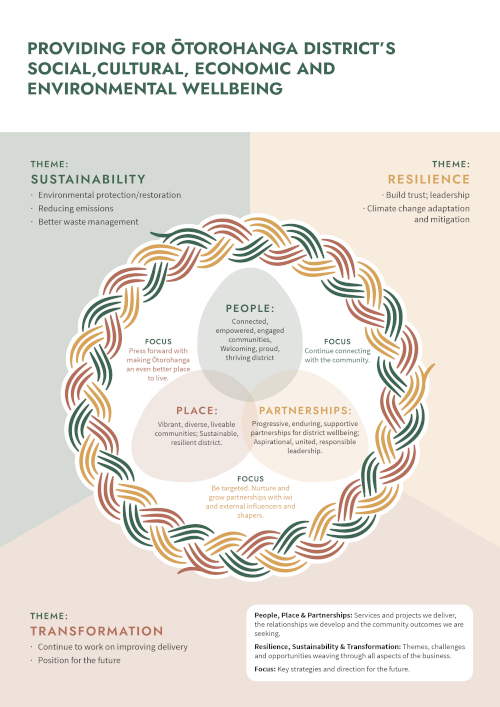Who are we?
Ōtorohanga District covers 1976 square kilometres of beauty, from the peaceful seaside towns of Kāwhia and Aotea in the west, to tranquil Lake Arapuni on the eastern boundary. There are two urban centres of Ōtorohanga and Kāwhia, surrounded by thriving rural communities.
The Ōtorohanga District is looked after by a team of 62 passionate people who are genuinely dedicated to providing the highest level of service to the people of the Ōtorohanga District. We’re excited about the opportunity to help build a vibrant district with prosperous and thriving communities that residents can be proud of.
Our direction, focus, priorities and major projects

We’ve considered what we must deliver and what we’d like to deliver and we’ve prioritised the essential items, but also want to invest in the ‘discretionary’ projects that help make our communities great places to be. We’ll also be looking seriously at what climate change forecasts mean for our communities and our services.
We intend to:
- take a greater role in leading in, for and on behalf of our communities
- build and maintain stronger, more productive relationships with our partners and stakeholders, particularly local iwi, and work collectively to improve the wellbeing of our communities
- maintain existing services and levels of services, with our road network continuing to be our largest spend area
- invest in our water supplies to meet national standards and assure continuity of supply
- work with Iwi, the Kāwhia community and stakeholders to establish the need for a new community wastewater scheme in Kāwhia
- optimise the performance of the Ōtorohanga wastewater scheme
- prepare, with our communities, future development plans for Kāwhia and Ōtorohanga, and update the rural community plan
- understand the likely impacts of climate change on our stormwater networks, and other activity areas, and reflect that in our ongoing work programmes
- ensure we have the right staff resources in place to deliver on our plans
- increase some of our fees and charges to reflect that a fairer share of the costs should sit with users
- get the funding of our water schemes on a more sustainable footing by reducing some of the long-standing budget deficits
- plan for new areas of growth – residential, commercial and industrial - and make sure our infrastructure is ready for it Ōtorohanga Long Term Plan 2021-2031 Ōtorohanga Long Term Plan 2021-2031 21 21
- do more to limit our collective environmental impacts, including reducing the amount of recyclables and food waste going to landfill
- better reflect arts, culture and heritage as an important part of our community and district identity
- partner with local development agencies to better promote our district and build vibrancy by having more events.
Community outcomes
We’ve been on a journey to create our community outcomes for the district.
In 2021, as part of the 10-year Long Term Plan, we held multiple meetings with residents from all over our district, as well as a staff working group. We asked everyone to consider the former community outcomes, and through this, a need for a change was identified.
Some innovative and passionate thinking led us to the following: Our community outcomes describe what we strive to be - as people, communities and a district.
Community wellbeing
While much of Council’s focus and investment will remain on managing and delivering core infrastructure services effectively and efficiently, increased emphasis will be placed on the wellbeing outcomes resulting from the services, as well as other services previously less prioritised where they contribute highly to social, environmental, cultural, and/or economic wellbeing of our community.